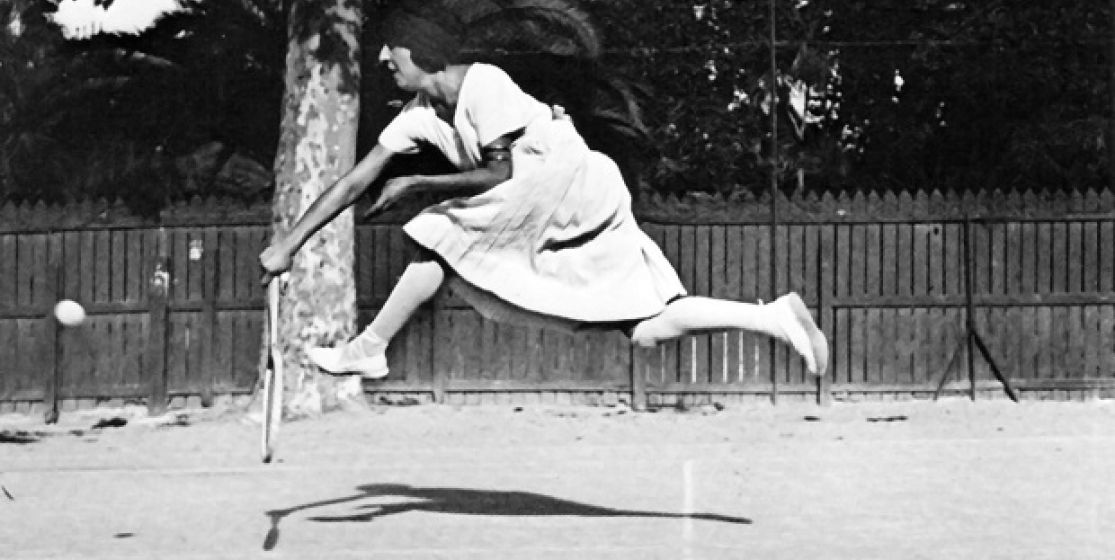This week, we’re headed to the Côte d’Azur with the ATP 250 tournament of Nice. A part of the french coast which, during the 19th century and a few years after the invention of tennis, became the center of this new sport. Let’s go back to the place which has seen Suzanne Lenglen’s first strokes, the birth of clay, and a few sunburns for english tourists.
It’s proudly exposed in the Roland-Garros museum, as it is one of its most ancient pieces : an example of the portable kit considered by historians to be the starting point of modern tennis. On February 23rd, 1874, Major Wingfield, an officer of the British army, registered the patent of a new game which he hoped to commercialize under the name sphairistike, a greek term meaning « art of the ball ». He’s planned it all. His small suitcases are filled with all the required equipment : four racquets, rubber balls which won’t damage the grass, a net with two stakes, strips to mark out the court and a booklet explaining all the riles. Just like football or boxing, tennis is a sport born in England, which was then exported throughout the world from the second half of the 20th century. Starting with France. « Tennis was introduced by English players born in aristocratic or middle class families who spent their holidays on the French coasts », explains Anne-Marie Waser in her book La Sociologie du tennis : genèse d’une crise. According to the researcher Jean-Michel Peter, there is no doubt about that : « Tennis started out as a beach sport, before conquering every seaside resorts…In a few years time, the kit became an essentiel in the equipment of the perfect tourist. » The kit created by Major Wingfield was first displayed on the coasts of Normandy and Brittany, from 1875, but very quickly arrived on the Côte d’Azur, as British tourists discovered the warm mediterranean climate. From there, the « French Riviera » will soon become the heart of world tennis.
Invention of clay
In a short spell of time, tennis quit the sandy beaches and it became hard to count the number of private properties equipped with courts. The Beau Site hotel, one of the most popular hotel of Cannes amongst the British, was not planning on being outdone : as their gardens were being enlarged in 1881, seven courts were designed by British champions William and Ernest Renshaw. When these twins weren’t dominating the sport (William won Wimbledon seven times and Ernest once in the singles, but five times in the doubles), they were staying at the Beau Site to teach a few lessons, organize tournaments and invent clay. How ? By noticing that grass wasn’t too resistant to the local temperature. With the heat, the grass turned yellow : they then had the idea of covering the courts with a thin layer of ocher powder, which came from the local fabric of clay pots in the nearby town of Vallauris. A new surface was born. At the start of the 20th century, you could find more than a hundred clay courts in Cannes only ! They were obviously visited by the high society, which saw in the racquet a sort of quest for social recognition. As the sociologist Monique de Saint-Martin explains in La noblesse et les sports de nobles, Tennis, as well as horse-riding, fencing or polo, was among the « free and selfless activities, where the way of being, appearing, and doing is more important than the performance itself. »
Viscount, « royal parties » et French bank
Nothing too surprising in seing the courts of the Beau Site Hotel, its green and shady landscape, welcoming the world’s elite. Suzanne Lenglen would frequently organise what she called « royal parties » between different crowned heads coming from all over Europe. A few years earlier, the Lenglen family, which was pretty well-off, was already spending its holidays in Nice. It’s even there, in the quartier des Musiciens, that Suzanne hit her first strokes. Legend has it that it was while watching the English, who came to take part in the spring tournaments, that her father had the crazy idea of making her a champion. Good call : at 15 years old, the « Divine » quit her country town to win the world championships on clay in Saint-Cloud. The year is 1914, and tennis has already conquered the Parisian region. In 1898, the viscount François Louis Léon de Janzé had a club-house and two courts built on the island of Puteaux. The opening ceremony of this sporting complex was supervised by the Grand Duke Vladimir of Russia. A year later, the Racing Club de France set its courts in Boulogne ; in 1901, the Stade Français did the same in the parc of Saint-Cloud. Before an other establishment laid the foundations of what will be known as the French Internationals. It’s name ? The Club Athlétique de la Société Générale, founded by the eponymous bank. In 1908, this club received a three hectares parcel of land in the heart of the Auteuil hothouses. Which will become the Roland-Garros stadium…and which, at the time, didn’t have a museum…






